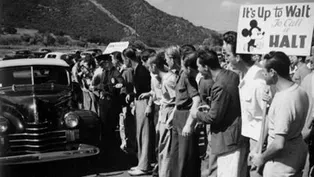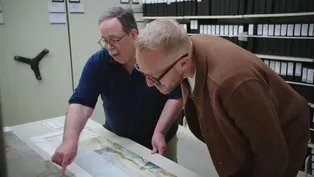
A Hollywood Dream Job Made Real
Clip: Season 7 Episode 4 | 4m 10sVideo has Closed Captions
Animotor Floyd Norman always knew that he wanted to work at Walt Disney's Hollywood Studio.
From a very young age, Floyd Norman knew he wanted to go to Hollywood to work for Walt Disney. After spending 10 years at Disney Animation Studios, Walt Disney himself asked Norman to join the story team. Norman would later go on to work at Hanna-Barbera, first on Josie and the Pussycats and later on a reboot of The Flintstones, featuring Fred and Barney.
Problems with Closed Captions? Closed Captioning Feedback
Problems with Closed Captions? Closed Captioning Feedback
Lost LA is a local public television program presented by PBS SoCal

A Hollywood Dream Job Made Real
Clip: Season 7 Episode 4 | 4m 10sVideo has Closed Captions
From a very young age, Floyd Norman knew he wanted to go to Hollywood to work for Walt Disney. After spending 10 years at Disney Animation Studios, Walt Disney himself asked Norman to join the story team. Norman would later go on to work at Hanna-Barbera, first on Josie and the Pussycats and later on a reboot of The Flintstones, featuring Fred and Barney.
Problems with Closed Captions? Closed Captioning Feedback
How to Watch Lost LA
Lost LA is available to stream on pbs.org and the free PBS App, available on iPhone, Apple TV, Android TV, Android smartphones, Amazon Fire TV, Amazon Fire Tablet, Roku, Samsung Smart TV, and Vizio.
Providing Support for PBS.org
Learn Moreabout PBS online sponsorshipMasters, voice-over: This unassuming garage, a faithful replica of the original, marks the starting point of Walt Disney's entertainment empire.
With a battered film camera and an animation stand cobbled together from spare lumber, Walt launched L.A.'s first animation studio right here in his uncle's backyard.
Waiting for me inside the house was legendary animator Floyd Norman, who got his start in the business working for Walt Disney in 1956.
Masters: This is such an amazing place and an important place in the history of The Walt Disney Company and animation, but it's really flown under the radar.
Norman: It really has.
Masters: Yeah.
Norman: As a matter of fact, I thought this home had been torn down decades ago.
Masters: Obliterated like so much else in L.A. history.
Norman: That's what we do with-- with L.A. history.
We bulldoze it down.
Masters: Sadly, sadly.
So what was it like to work for Walt Disney?
Norman: It was a kid's dream come true.
When I was a kid growing up in Santa Barbara, I learned about motion pictures in my junior high school library.
I learned about animated films in particular, but I did learn one thing.
I knew that one day, I wanted to go to Hollywood and make movies.
I wanted to go to The Walt Disney Studio and work for Walt Disney.
Masters: Yeah.
Norman: And guess what happened?
I got a chance to do all of that.
Masters: Wow.
You got your dream job.
Norman: I did.
I truly got my-- my--I did not want to go home at the end of the day.
After I had been at the Disney studio for 10 years, Walt Disney decided that I was not an animator, but that I belonged in his Story Department.
And that's how I ended up working on "The Jungle Book."
And think of what a lucky kid I was back in 1966 to have had the privilege of working with Walt Disney-- Masters: Yeah.
Norman: on his last film.
Masters: Last film.
So, when the average person hears the word or the job title "animator," they might think somebody with a pencil drawing a cartoon character, but there's really a lot more to it than that.
Norman: Mainly, we tell stories visually.
Keep in mind, the animator is an actor with a pencil.
Masters: Ahh... Norman: And they put that performance basically on a sheet of paper.
Norman: You also worked for another storied animation outfit.
Norman: I left Disney around the early seventies, and I was offered a job at Hanna-Barbera.
Totally different from Disney.
I remember the first show I worked on was "Josie and the Pussycats."
And then after "Josie," we did a reboot of "The Flintstones."
We thought we'd have all this material to pull from, but it turns out that Hanna-Barbera had thrown away all that early stuff they had done in the 1960s.
It had gone into the dumpster-- Masters: Oh, wow.
Norman: which meant we had to re-create "The Flintstones" from scratch.
Masters: Do you remember your first experience with animation?
Norman: My first experience was probably in middle school, and I decided to make my own animated cartoon.
And back in those days, you had to make all the art material yourself.
You couldn't go out and buy it.
So I had to get sheets of plastic and cut it up and punch holes in them and basically create my own production process.
I was shooting 16 millimeter Kodachrome, and I remember how glorious that film looked.
Masters: When you were just telling me about how you had to scrounge for materials and make your own set-up, that reminds me of what happened in this garage over here.
Walt Disney had to build his own camera rig, right, to-- to create his animation camera.
Norman: Yeah, that's what Walt and his brother Roy had to do.
Masters: Yeah.
Norman: You know, they had to basically build their own studio, starting from scratch, starting in that garage.
Masters, voice-over: I asked Floyd if he could teach me some basic sketching in the place where L.A. animation was born.
Norman: This is a cartoon version of you.
Masters: This is like magic.
That took you less than 30 seconds!
I mean, is there anything that you can just guide me through drawing?
Norman: Draw a circle.
Masters: Draw a circle.
OK. Norman: This is gonna be the body.
Masters: OK. Norman: Let's give him some eyes.
Masters: OK. Oh, big ones.
There we go!
Ha ha ha!
Norman: Ta-da!
[Blink blink] All right, folks.
As Porky Pig would say, "T-t-t-that's all folks."
["Looney Tunes" theme playing]
Video has Closed Captions
Uncover Disney’s LA roots and how the city became the birthplace of modern animation. (30s)
Inside the Animation Research Library
Video has Closed Captions
Nathan goes frame by frame through the Walt Disney Animation Research Library. (2m 58s)
Providing Support for PBS.org
Learn Moreabout PBS online sponsorshipLost LA is a local public television program presented by PBS SoCal













